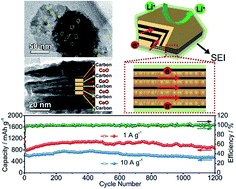Sandwich-type nanoporous CoO/N-doped carbon multi-layers with ultrahigh lithium storage and long-life stability†
Abstract
It is critical to fabricate special electron transfer channels and conductive buffer layers in order to obtain efficient electrode materials using interfacial engineering. In this research, ultrathin carbon layers were intercalated into 5 nm thick cobalt oxide (CoO) sheets and used to form porous sandwich-type CoO/nitrogen-doped carbon multi-layers (s-CoO/N–C MLs) with multiple hetero-interfaces. These materials were tested as lithium ion battery anodes, and the reversible capacity of this multi-layered sandwich structure reached 1031.2 mA h g−1 at 0.5 A g−1 after 500 cycles, which was superior to multi-layered nanoplatelets without carbon. The composite also exhibits a high specific capacity of 864.8 mA h g−1 with ∼100% capacity retention at 1 A g−1 and 538.8 mA h g−1 with ∼90% retention at a high current density of 10 A g−1 even after 1200 cycles. The electrochemical measurements reveal that the s-CoO/N–C MLs take up a 71.3% charge contribution from the capacitive-controlled capacity, resulting in excellent rate performance and long-term cycling stability. The much enhanced performance could be ascribed to the interlayer ultrathin carbon of the unique sandwich structure, which could provide electron transfer channels, offer extra lithium storage sites, and serve as buffer layers for volume change during the lithium ion insertion/extraction process. This research may provide insights into the design of hetero-interface advanced electrode materials.



 Please wait while we load your content...
Please wait while we load your content...